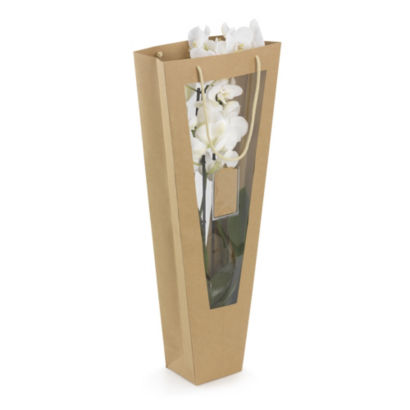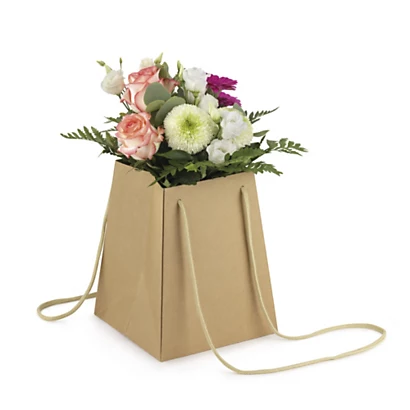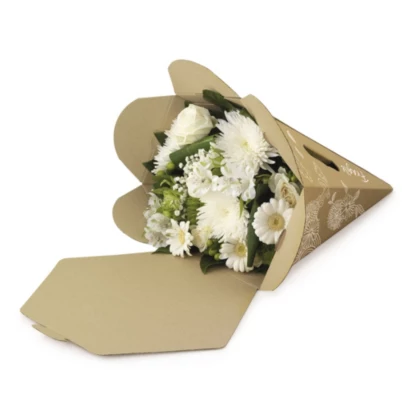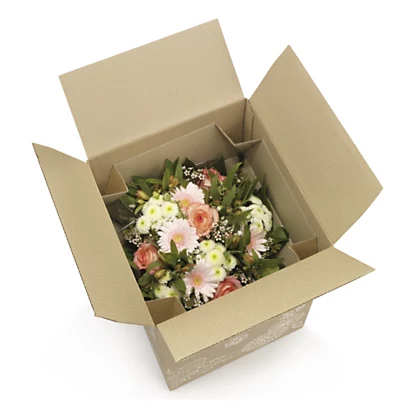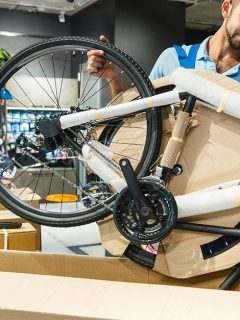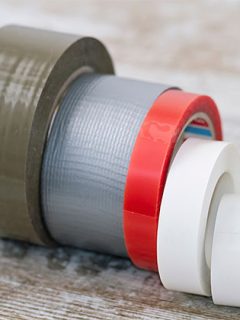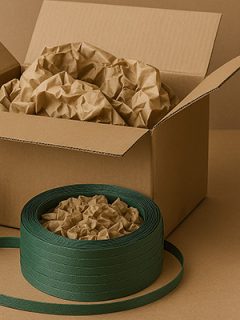According to a RAJA survey, 84% of the e-commerce retailers surveyed want solutions on how to pack their goods properly – and packaging processes that are individually tailored to their logistical challenges. What sounds simple at first – goods are packed in a carton, the carton is taped shut and shipped – is often more complex in reality. You should take numerous elements into account: The size and weight of the products, the quality of the padding and packaging, and finally, how you seal the carton to ensure transport safety. Correctly packed packages also support your forwarding agent and the postal service. This means that packaged goods arrive faster – and above all in one piece. Only if you ensure smooth shipping can you be sure that your customers will order from you again.
We have compiled the most important packaging tips.
This is what you can expect in this blog post
- Asking the right questions: Which questions need to be clarified before packing?
- What else do I need to consider when packing?
- Which packing sequences are correct?
- How can I save time and money when packing?
- FAQ: Packing for the special case
Asking the right questions: Which questions need to be answered before packing?
The be-all and end-all if you want to package your products properly is the right preparation. Especially when you order new packaging materials, you should ask yourself basic questions in advance:Where: Where should the shipment be sent?
A domestic shipment has less stringent requirements for transport-safe packaging than a shipment abroad. As a rule of thumb, the further and longer the shipment, the more stable the packaging should be. You should also familiarise yourself with any shipping regulations abroad.
What: What do I pack in boxes, crates or crates?
The right packaging is essential for safe shipping. In the course of this blog article, you will learn what is important.
When: When should my products reach the customer?
A prompt shipment of goods is expected by your customers, especially in e-commerce. Efficient and correct packaging is the basis for this.
How: How do I want to ship my goods?
By forwarding agent or by post? A question that is anything but trivial. Courier professionals may be more expensive, but they are specialised in transporting even complex products safely.
How much: How many products do I pack in one box? How many parcels do I send per year?
If you pack several products together, you will need to handle and cushion them differently. If you send a lot in a year, some shipping services offer special conditions. In addition, RAJA offers discounts on many packaging materials if you buy them in large quantities.
Why: Why do I want to use this type of packaging?
It is worthwhile for you to question why you package a product the way you do. Just because you’ve always packaged it the same way doesn’t mean there isn’t a more efficient packaging solution that will save you time and money.
What else do I need to consider when packing?
The delivery promise: An important topic!
Disappointment is a common reason why someone does not return to order from you again. All your sales and marketing efforts would be in vain if your customer expectations are not met in this crucial step. Clearly, you need to deliver quickly and you need to deliver safely.
The first and important step has been taken: the customer has come into contact with your brand. In the following purchase decision process, he or she will have various points of contact with your company; until at the end of the “customer journey” there is (hopefully!) the purchase. But this is not where your efforts should stop! The customer journey may have run smoothly and without problems up to that point: Unfortunately, all that is immediately forgotten if the promised delivery expectation is not fulfilled.
Conclusion: For customer satisfaction, the delivery is just as important as the purchase.
How does seasonality affect my business?
In both B2B and B2C, for example, the Christmas season means you need to prepare for packing goods differently than at other times of the year. For example, expanding board game manufacturer IELLO has two key periods that need to be carefully planned by its logistics team.
From May to June, they distribute their best-selling products in anticipation of the Christmas sales. They pack them on pallets and large boxes and ship them in large quantities to retailers over a short period of time.
The other “business pillar” is direct sales on their e-commerce website at the end of the year. This is pure B2C logistics with a focus on fast delivery to the consumer. They have to pack and deliver quickly and ensure that the package reaches its destination in one piece.
Conclusion: Depending on the season of your business, you need to instruct your staff exactly how to pack goods optimally. Appropriate packaging materials should be sufficiently available.
Which packing sequences are correct?
The ABC of packing
- Step: Select the package packaging
- Step: Pad and wedge the product
- Step: Close the parcel
- Step: Ship the package
The right packaging: How do I find the right shipping packaging for my product? How should a package be packed?
Whether it’s a cardboard box, a corrugated cardboard folding box, a DIN-format shipping bag, a shipping pouch or bulky goods: the wrong choice of packaging can lead to damage during shipping and disappoint your customers. A dented, damaged folding box does not make a good impression when it is received.
But the choice of packaging also affects the speed of order preparation. By making the right choices, the packaging team can work more efficiently. Which means more orders per hour are packed with less effort. The time saved can go into other areas of the packaging process – such as quality checking each package to reduce packaging errors.
How you pack your shipping goods depends on a number of factors; these include: The sensitivity or fragility of the item being shipped, its size and weight, and how it is being transported.
What type of packaging do I use for packing?
The decisive factor is which product is to be packed. This will determine the type of packaging you will use. In fact, a fragile product requires a sturdy cardboard box, while an unbreakable product (e.g. a jumper) can certainly be shipped in a plastic bag.
Packing with shipping bags:
Shipping bags made of paper or cardboard are suitable for insensitive products. Corrugated cardboard or cardboard envelopes are mainly used to pack books, DVDs, CDs, folders and documents for which a cardboard box is too large. Flexible mailing bags with a pressure-sensitive adhesive seal with variable filling height are particularly time-saving.
For smaller, more delicate products such as jewellery, picture frames or electrical components, padded envelopes come into question.
Packing with shipping bags:
Shipping bags made of PE or other film material are waterproof and are particularly suitable for non-sensitive items that may also be bent, such as textiles. However, it is also possible to pack bulky goods waterproof with large shipping bags.
Packing with cardboard:
Cardboard boxes such as the folding box are the classic: they are particularly suitable for heavy packages, sensitive products or when several products are packed together.
There are different cardboard thicknesses, which are determined according to the weight and type of product: single-flute, double-flute or triple-flute corrugated cardboard boxes. The quality of the corrugated board is also decisive. Always remember that parcels are handled, stacked, loaded and unloaded several times between your company and your recipient – with more or less care! So if in doubt, better choose the folding carton made of the sturdier corrugated cardboard.
How big does my box need to be?
Ideally, you should add approx. 5mm to the dimensions of your shipment. Bear in mind that padding or filling material also needs space in the box. If you are unsure of the height of your goods to be packed, variable telescopic boxes and boxes with telescopic lids are ideal.
Not all sales packaging is the same as shipping packaging
Especially for electronic products, an important note is in order at this point: Often, these are already delivered in a small cardboard package. However, you should not simply use this as shipping packaging. This “sales packaging” is usually elaborately printed to look more attractive in the shop and thus “sell better”. However, the advice of the shipping service providers is clear: shipping packaging should not give any indication of the contents, otherwise the incentive for theft is much higher. In addition, this packaging is not designed for shipping and is therefore less able to withstand mechanical stress on the one hand and less resistant to environmental influences on the other. All in all, this can lead to your consignment arriving at your customer’s in packaging that has been soaked and damaged by the rain, with the contents also damaged. An experience you want to spare yourself and your customer. In addition, they are usually not optimised for the usual postage.
Tip: With our box finder you can easily find the right box size.
Packing step 2Pack properly: How do I pack safely? How do I pack delicate goods?
You have now chosen a package with the right dimensions that is strong enough to protect the product. But that alone is not enough to secure the product for transport. Sensitive goods and glass in particular must be adequately secured.
There are various types of filling material and cushioning material for this purpose: wrapping paper, kraft paper, bubble wrap, air cushions, foam, paper chips, etc.
How do I pack my goods safely?
- If the item is fragile, you can wrap it in effective protective packaging such as bubble wrap (some particularly thick films are very protective.
- If the item is not fragile but could be damaged by bumping against the corners of the cardboard packaging, choose a cushioning solution such as packing paper or air pillows.
- You should fill empty spaces when packing as much as possible. Cavity fillers are suitable for this purpose.
How do I protect sensitive products?
- Electronic products require antistatic padding, such as antistatic bubble bags.
- Some items are acid-sensitive and require PH-neutral padding (this applies to artwork, for example).
- Others may need to be packed with waterproof stretch film to protect them from external weather conditions. You can find out exactly how this works in the following blog article.
- Finally, there are surfaces that are more prone to scratches and need effective yet gentle protection.
- Discover more solutions on how to pack your goods safely on our online shop landing page.
How do I pack with shrink film?
With shrink film, you primarily pack several items of the same type into handy bundles. It is not suitable as outer packaging for shipping, but rather for presentation at the POS. However, shrink film is also used as an alternative to stretch film when packing pallets.
Stacking up correctly: How do I pack a package with several products?
If several products have to be packed in one box, base the choice of cushioning material on the most sensitive product. If the weight of the individual products is different, it is advisable to pack the light fragile goods in a smaller box, which you enclose with the larger outer box. Why? During transport, centrifugal forces in the box can cause the items to move and bump against each other. The heavy goods can damage the lighter items in the process. Therefore, sufficient suitable cushioning material is essential.
Proceed as follows:
- Choose a sturdy box with enough space for all products and filling material (remember the 5 mm rule).
- Place heavier items at the bottom of the shipping carton, padding them with kraft paper, for example.
- You can pack insensitive, flexible products as an intermediate layer.
- Place light and fragile items at the top. Pack them very carefully and wrap them in bubble wrap, for example. Or pack them in advance in a small folding box, which you add at the end.
- Fill any voids with paper cushioning chips, kraft paper or other void fill.
- Label your package so that shippers know which side belongs on top – otherwise it may be upside down during transport and the heavy products may crush the lighter ones.
Tip: Packed in bubble wrap, products are additionally protected from moisture.
Packing step 3
Close properly: How do I close my package properly when packing?
Now that your product is in the appropriate packaging, protected by effective padding, you can close your parcel securely for transport. This sounds obvious, but there are some rules you should follow.
Packing with tape: Choose a strong packing tape with a width of 5 cm so that the shipping package does not open by itself. With a roll of tape, you can seal your box in different ways:
- L-shaped: for light products
- In a U-shape: for heavy products or the transport of products that will pass through several transport stages.
- In a combination of L and U: for transporting heavy products over a longer period of time.
- In H: a very safe method suitable for all products.
| Light parcels up to 20 kg | Parcels up to 40 kg | Heavy parcels over 40 kg | |
| Low-noise PP packing tape | X | X | |
| PVC packing tape | X | X | X |
| PP packing tape | X | X | X |
| Reinforced adhesive tape | X | X |
Packaging with strapping tape: If you strap a folding box, it is secured and cannot be opened unnoticed. However, this method is only suitable for delivery by forwarding agent but not by post, as the strapping could otherwise get caught in the conveyor belts and tear open.
Tip: Do not use too much tape and, if possible, choose neutral colours such as brown or white for the packing tape. This makes it easier for the post to be sorted by machine. If, on the other hand, you use a lot of packing tape or bright colours, it may have to be sorted manually – which means extra costs for you.
Tip 2: Printed boxes and personalised tape adds an individual touch and increases your customers’ anticipation of unwrapping the package. RAJA pays attention to colours suitable for shipping.
Packing step 4
How do I send my parcel properly?
The most important thing is done, the parcel is well packed, protected and sealed. Now it just needs to arrive in good condition! You should affix shipping labels to the package as follows:
- The addresses of the consignee and the consignor must be clearly visible on the document bag, as well as the barcode of the waybill;
- Consider labels such as “International”, “This Side Up” or “Fragile” so that the carrier can take some precautions during transport.
Tip: Compare shipping prices! Your usual forwarding agent or shipping service provider is not always the best option. Get quotes, some service providers offer special rates for large volume orders.
Packaging tips for advanced users:
How can I save time and money when packing?
If you pack correctly, you can save time and money. In addition to good planning and a team that knows all the necessary moves, the right packaging material, practical tools and the right forwarding partners will help you most of all.In this way, not only do you save valuable resources, but you also ensure faster shipping and higher turnover. And – almost as a side effect – make your customers even more satisfied.
RAJA’s consultants are specialised in finding the perfect solution for our customers. arrange a consultation.
Save time: How can I pack faster?
Packaging with packaging machines: More orders mean more sales – but also more packages and… less time? The latter does not have to be the case. At the latest when orders threaten to overrun your head, you should think about packaging machines. Such an investment may seem intimidating at first, but it pays off in time saved and employees relieved. You can simply pack and ship more per hour. We explain what you need to look for in a packaging machine in the blog article on process automation in packaging.
But even without packaging machines, you can save time with clever packaging solutions:
- Automatic bottom boxes fold up quickly and can be stored to save space.
- With padded envelopes with adhesive strips, you can pack, pad and seal your shipment in just one step.
- An organised workplace means less searching for the right packing materials. With a packing table, your employees can pack more efficiently and ergonomically. This also benefits their backs and health and safety…
Tip: Here we have compiled further blog articles on the topic of cost and process optimisation.
Save money: How do I save money on packaging and shipping?
Simply by packing faster, you also save money. Because: You reduce personnel costs and freed-up resources can be used profitably.
However, there are also a few tricks you can use to pack goods cost-effectively:
- Size:Choose packaging that is as large as necessary, but also as small as possible. Many shipping service providers charge according to the dimensions of the shipping packaging.
- Weight: Use lighter packaging materials whenever possible: air cushioning weighs less than paper cushioning, a shipping bag less than cardboard.
- Shape: Ideally, pack your products in common packaging formats that can be processed by machine. Unshaped or very large packages often have to be handled manually during shipping, which means higher shipping costs. Take into account the specifications of your shipping service provider.
- Colour and material: We have already given a tip on this above: Avoid flashy boxes and too much tape. Choose common shipping materials such as cardboard or foil bags in brown or white.
- Large quantities: Calculate or estimate your sales per year and buy shipping materials less often, but in larger quantities. RAJA offers quantity discounts on many items in the range and free shipping on orders over a certain amount.
- Special conditions: If you are lucky, shipping service providers also offer you special conditions from a certain shipping quantity per year. It pays to ask!
Read our blog: In our blog we have compiled many more ideas and tips on how you can, for example:
Tip: Reducing weight and optimising postage when packing should never be at the expense of transport safety. If the contents arrive damaged because you have skimped on the cushioning material, for example, it will cost you more in the long run – and in the worst case, your customers as well.
FAQ: Packaging for the special case
How do I package in an environmentally friendly and sustainable way?
If you want to pack products sustainably, it is obvious to reduce the amount of packaging (bonus: less weight = lower shipping costs). You should also use environmentally friendly packaging. RAJA offers more and more shipping solutions with recycled content. In our blog you will find more information on how to already protect sustainably when packing; you will learn whether paper pads or plastic pads are more sustainable and whether reusable returnable packaging with a deposit system could be an option for you.
How do I wrap a gift?
Whether you wrap gifts as a service or want to give customers a surprise: Individual gift wrapping makes an impression. However, gift wrapping can mean a lot of extra work for you. Simple solutions that create an eye-catcher without much effort are a remedy. Classics are decorative filling material such as tissue paper as padding, ready-made decorative bows or simply a ready-made gift box in which you can wrap gifts in a flash. On our shop focus page you will find everything for gift wrapping at a glance.
In our blog you will find more information about gift wrapping.
How can I wrap flowers?
Don’t be bent! Sending flowers was not very popular for a long time – there were far too many concerns that they might not arrive in one piece and thus defeat their purpose: To make people happy! In the meantime, however, there are more and more online senders of flowers. How can flowers be packaged safely? With optimised, special packaging for flowers. You can find out what to look out for in our blog article on the subject of “Packing flowers”. RAJA also offers a wide range of special packaging material for packing flowers.
How can I pack bottles?
The easiest way to pack several bottles is to use specialPTZ bottle packs with compartments that are optimised for postal shipping. The integrated compartment ensures that bottles remain upright and glass arrives intact even without additional padding.
If you want to pack individual bottles, a flexible corrugated cardboard protector will support you.
No matter what kind of liquids you are packing, you should always mark the cardboard box with “This Way Up” or a double arrow so that nothing leaks out.
You can findmore tips on safe bottle shipping in our blog. Cheers!
How can I pack merchandise and book shipments (DE)?
Sending goods as book and merchandise shipments is a popular way to reduce postage costs in Germany. You can pack book shipments as parcels with either a total weight of up to 500 grams or up to 1000 grams. Maxibrief boxes, for example, are suitable for this.
The special feature: no letters or written notices may be enclosed in the parcel (except for the invoice, delivery note and documents relating exclusively to the delivery item) and the parcel must be marked “BÜWA” on the outside.
How do I have to pack a parcel?
Small packages are one of the most popular forms of packaging for shipping small goods. You can find out what else is important when you pack a small parcel here.
How can I pack electronics?
Packing electronics is quite easy if you follow a few rules when packing them. The most important thing to know is that when packing electronics, you should not simply pad them with normal bubble wrap or other plastic films. These could statically charge electronic components and cause a short circuit. In the worst case, electronic items would arrive at their destination broken. It is better to use antistatic packaging. You can find out in detail how to optimally pack electronics in the blog article of the same name.
How do I pack bulky items?
Whether it’s a removal company, online retailer or freight forwarder: bulky items must be carefully packed to make them safe for transport – and to deliver them undamaged to the recipient. As we have already mentioned above, each forwarder or shipping service provider specifies the dimensions and weight of bulky goods. Small bulky goods can be delivered in cardboard boxes or shipping tubes. However, cardboard packaging is not the best solution for large, bulky goods. To secure the load and protect it from scratches and moisture, you should wrap it with kraft paper or stretch film – or stretch paper.
You can find outwhat else you should look out for in our blog article on “Packing bulky items”.
How does packing on pallets work?
For some it is the supreme discipline: packing on pallets – or, in technical jargon: palletising. In order to pack pallets correctly, you have to take a few things into account. Your best friends are stretch films and pallet securing devices. We provide an overview in our blog article on: Packing pallets – palletising made easy.
Packing for freight forwarding
Packing for forwarding usually means packing bulky goods and/or packing on pallets. You can find tips on this a little further up, or here.
Conclusion
Packaging from A to Z
Packaging can seem overwhelming at first. But with good planning and the best quality packaging materials, you can create high-quality, cost-effective packaging that will ensure your packaged goods arrive safely. That’s a promise: With minimal practice and a little know-how, it’s a snap.
You want to be ahead of your competitors?
Our RAJA experts will be happy to advise you and work with you to find the optimal packaging process for your company. Because the optimal packaging process is as individual as your product.











